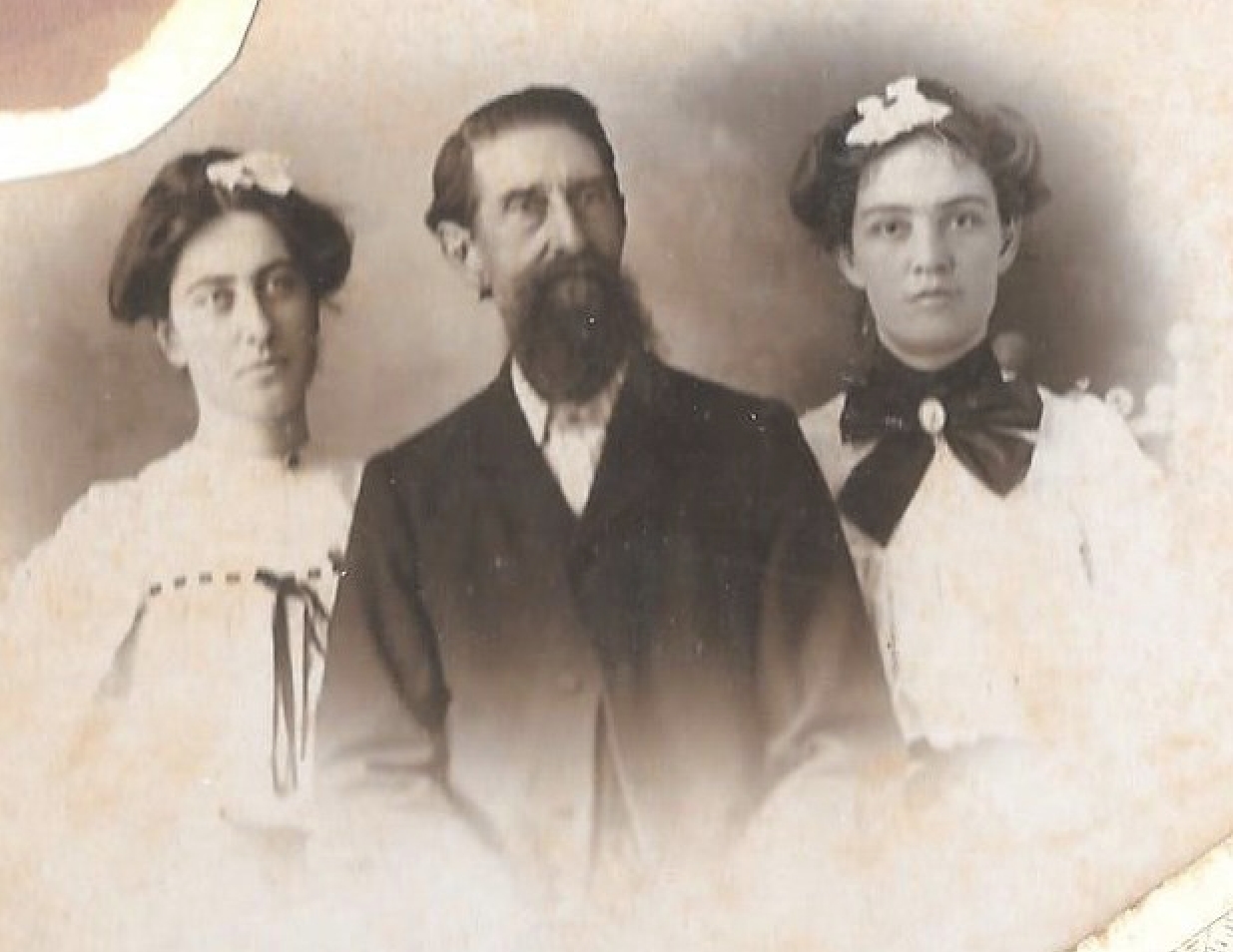In May 2024 I was contacted on Ancestry by Kate Kelley, aka “The Photo Angel” as seen on NBC’s The TODAY Show
I acquired an antique portrait of a father and his daughters that I would love to return to a family member! Names include Uncle Jim Thornton, Olivia, and Fannie. The back mentions that Olivia married a man by the last name Burns. Are you a blood relative of the Thorntons and if so, what is the relationship?
I responded:
That is so weird. I was just working on this exact line this morning. I am related to these people, but very distantly. My brother’s ydna test ties me to the father of a woman (Aimee) whose line of Thorntons were in Tennessee. That line is connected to the Thorntons in your photo in Alabama. My Thornton branch went into Virginia and we have been trying to document the link between the three lines. According to my tree, “Uncle Jim” Thornton would be James Clark Thornton, born 1842 in Stevenson, Alabama. His daughter Olivia was born 1876 and Fannie (Mary Francis) was born 1877. Olivia married Jasper Clark Burns in 1896 in Texas and they had at least 3 kids. Jim’s father was Joseph Thornton, born 1805. I would love to get a good scan of the photo for my own use, but I’m probably not the right person to give the real photo to if an actual descendant can be found. I would be pleased to assist you in tracking down some of the descendants – I enjoy doing that every so often when I find a photo on ebay.
I immediately started researching Uncle Jim and his daughters and decided to use this as a test case for my new “A Picture and 1000 Words” service. Having just filled in some records I didn’t have a lot to do before I could start working on a story about the people in the photo. The hardest part for me is to STOP researching, and I went over 1000 words a little. I just love finding out all the little details and connections.
 Uncle Jim Thornton and his daughters Olivia and Fannie. Photo ca 1890, Robertson County, Texas
Uncle Jim Thornton and his daughters Olivia and Fannie. Photo ca 1890, Robertson County, Texas
James “Jim” Clark Thornton was born June 17, 1842, in Stevenson, Alabama, the youngest of eight children of Joseph Thornton and Mary Polly Henry, the great granddaughter of the American patriot Patrick Henry. He grew up on his parents’ farm in Jackson County on the Tennessee border.
Lincoln’s election in 1860 triggered mounting tensions resulting in the secession of the Southern states starting with South Carolina on Dec. 20, 1860. Alabama quickly followed 3 weeks later as the 4th.
In February 1861, the newly elected President of the Confederacy, Jefferson Davis, visited Stevenson, a momentous event for the small hamlet, and reportedly gave a defiant speech: He was saluted with gun and fireworks and the houses were illuminated. In his speech he said “You Border States will gladly come into the Southern Confederacy within sixty days as we will be your only friends. England will recognize us and a glorious future is before us.” Republican Banner, Nashville, Tennessee, Feb 16, 1861. Two months later they began organizing a volunteer army.
Soon after, two of Jim’s brothers answered Jeff Davis’ call in late 1861. George and William mustered into Co. C of the 49th Alabama Infantry under General John Breckenridge who had been Douglas’ running mate against Lincoln. On April 6, the 49th took part in the Battle of Shiloh with 113 killed or wounded of the 24,000 total casualties.
Jim followed dutifully in April, and at the age of just 19, he joined his brothers in Company C as sergeant. One month later, they helped defend Vicksburg, suffering nearly 400 casualties.
A plan to retake Baton Rouge sent what was left of the 49th, now less than 100 men, to Louisiana. In the heat of the summer, they boarded trains to Camp Moore near Kentwood, Louisiana and joined 5000 men for the assault on Baton Rouge. The battle raged for six hours before Breckinridge realized it would cost too many men to take the city and he withdrew. 45 in Jim’s Company were killed or wounded. Also among the Southern dead – Alexander H. Todd, President Lincoln’s brother-in-law.
The 4th brother Joseph enlisted in Tennessee in late ‘62 and was assigned to the Niter and Mining Corps supplying the Confederacy with minerals and metals.
Meanwhile Jim, George and William saw more action at Corinth, Mississippi in October. After two days of hand-to-hand combat, they were again forced to retreat and again suffered severe losses.
In May 1863, the 49th moved to Port Hudson, Louisiana, a crucial position on the Mississippi River as one of the last crossings besides Vicksburg open to the Confederates. Despite its strategic advantage on a bluff on a hairpin turn in the river, 6,800 Confederate troops were no match for the gunboats and 30,000 Union soldiers. The siege dragged on for over a month and with practically all of their food supplies and ammunition exhausted, the Rebels resorted to eating their mules and rats. Finally, when Confederate Maj. Gen. Gardner learned that Vicksburg had fallen on July 4, he realized his situation was hopeless, and on July 9, he surrendered, ending 48 days of continuous fighting and giving the Union control of the Mississippi river.
Under the terms of surrender, the enlisted men were paroled and the officers were loaded onboard a steamer and sent to prison. Jim was among those paroled and sent home until the end of the war. But many from his regiment, including his two brothers, were sent back into battle, going on to the Siege of Atlanta in 1864 to defend against Sherman’s onslaught, and by war’s end in 1865, the 49th was reduced to a mere 50 men.
When Jim returned to Stevenson, he found his hometown had become a Union stronghold while he had been away fighting in vain to keep the Union from taking control of the Mississippi River. Stevenson was located at the junction of two major railroads and had been captured shortly after he had left in April 1862. They ransacked the county for supplies and livestock and constructed a fort with 14-foot walls and cannon platforms atop a hill overlooking the town and railroads to prevent the Rebels from moving supplies and troops through the area. They also established a hospital and a refugee camp in town.
While his brothers continued the fight, with George captured in 1865, Jim lived under the shadow of Union military rule, helping protect and care for his parents and sisters. When their town was finally released from the grip of the North at the end of the war, his brothers returned and they were left to pick up the pieces and find a new normal. In 1867 all four brothers registered to vote in Jackson County on May 1 alongside blacks in their community.
Jim’s father died in 1869, and the 1870 census found Jim still living with his widowed mother and sisters Martha, Nancy and widowed sister Malinda and her daughter Jane on the family farm in Fackler just south of Stevenson.
Five years later, at the age of 32, Jim married Rachael Ann Jennings, age 20, in June 1875. The couple may have met each other through his Thornton cousins in Marion County, Tennessee [adjacent to the north] where Rachel had lived in 1870.
Jim and Rachel had two daughters, Olivia, born in 1876 in Stevenson, and Fannie, born April 13, 1877. Two months later, Rachael died at the age of 22. Most widowers with young children usually remarried immediately, but Jim chose not to, devoting himself to raising his daughters with the help of his family, especially his spinster sister Martha, who moved in to care for him and the children.
Around 1882 Jim and his daughters moved to Robertson County, Texas, likely following after his late wife’s parents who had settled there a few years earlier during a wave of immigration out of the Old South attracted by fertile and relatively inexpensive land. Several of Jim’s siblings and extended family also moved to Robertson County, a Democratic stronghold during the Jim Crow era. He and his daughters farmed 125 acres in the Bald Prairie community.
Fannie never married. Olivia married Jasper Burns in 1896. They had three children: Basil, Jewel, and Francis, named after her sister.
Towards the end of his life, Jim suffered from asthma, heart trouble, and senility. He died at Olivia’s home in Franklin, Robertson County in 1928 at the age of 85.
Olivia died in 1953 at the age of 77. Fannie died in 1972 at the age of 94.
[Editor’s note: Robertson County is just north of Brazos County where my alma mater Texas A&M University is located and where one of my ancestors John Wagner moved to after the Civil War. His wife Lucy Millican lived in Robertson County in the early 1900s.]
[Geographic note: Just north of Robertson County is a tiny town called Thornton in Limestone County, which may be connected to Jim’s family somehow.]
If you’d like to have a photo researched, please check out my
Meet Your Ancestors Photo Research Package.

